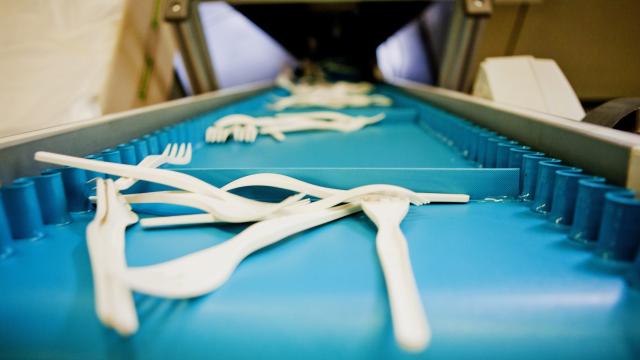If you’re not the type to bring a reusable bag to the store, bioplastics have become an increasingly attractive alternative to the plastic that is slowly strangling the oceans, rivers, municipalities, and the very sediment record of Earth itself.
The name itself evokes nature, the packaging is often coloured green, the labels highlight how it was made from corn or compostable. There’s something sweetly seductive looking at a bioplastic cup and imagining it ending up in a huge compost pile where it will natural degrade over a few weeks or months into fertiliser that can be used to grow more corn. Ashes to ashes, dust to dust. And it yet it’s mostly a dream, sold by the companies who make the plastic and perpetuated by our broken recycling system.
The truth about bioplastics is much more messy and points to the fact that we don’t really have a good solution yet for how to deal with the copious amounts of plastic waste that are permanently befouling all corners of the globe.
[referenced url=” thumb=” title=” excerpt=”]
Bioplastics date back more than 160 years, but they’ve seen a surge in interest and production in the past few decades. In 2018, the world produced 2.6 million tons of bioplastic, according to data from the Institute for Bioplastics and Biocomposites (IFBB). That’s a fraction of the 300 million tons of plastic produced, but IFBB also projects bioplastic production could grow 65 per cent by 2023.
More bioplastic isn’t inherently bad. Done right, it could reduce plastic carbon emissions by up to 3.8 gigatons by 2050. But the done right part is the key, and so far, the world has shown little propensity to do that.
Bioplastic actually breaks into two categories: plastics made from plants and algae and plastic that biodegrades over time. The companies producing each of these types of plastic have in some ways banked on the hazy label bioplastic to make their plastic seem more environmentally friendly than regular old plastic made from oil.
“It has been controlled as a marketing arm, not a science one,” Taylor Weiss, an engineering working on algae-based plastics at the Arizona State University, told Earther. “Companies who say “˜this is biodegradable,’ just because it’s possible, it’s not likely.”
The most common form of bioplastic is PLA, a hard plastic that can replace the bottle, cups, and other vessels. It’s biodegradable and companies that sell PLA products often play that up from their names like Planet+ and Repurpose to their green branding. But what the companies don’t advertise as clearly is that while these cups are compostable, they need to go to the proper facilities.
“PLA is biodegradable but it’s biodegradable like wood,” Weiss said. “It will degrade over time but you’ll need industrial facilities.”
Flicking one into your recycling bin won’t get it there. Instead, it “can contaminate and disrupt the recycling stream if intermixed with petroleum-based plastics that are non-compostable,” according to the Environmental Protection Agency. And most municipalities simply don’t have a a curbside compostable plastic pickup. That means your compostable cup will usually end up in a landfill.
In fact, most of your recycling China banned many recyclable items it used to import and U.S. facilities don’t have the capacity to handle that. Once in a landfill, the PLA will breakdown, but like the plants it came from, it will emit greenhouse gases.
“If it’s a section of landfill with open recycling pits, it’s eventually going to become carbon dioxide [as it biodegrades],” Weiss said. “At worst, it could become methane, which is extremely more potent.”
Unlike plants, any benefits from its breakdown will not go back into the soil. Instead, its remnants will fester in a huge pile of garbage. Not exactly regenerative!
In addition, PLA is much like biofuels that can displace food production. The world population is projected to balloon to 9 billion by midcentury, and research has shown we’re going to need all the land we can get.
The algae- and bacteria-based bioplastics known as PHA offer a more effective avenue to reducing the forever-impacts of plastic, getting us closer to a circular economy. But it’s still more expensive to make that type of bioplastic and like PLA they require proper sorting and recycling.
There are a few fixes in the interim like improved bioplastic labelling that makes clear how likely it is to be composted, akin a program in the UK for regular plastics. The industry itself could also be better-regulated and municipalities could do a better job educating residents about what to do with bioplastics in the first place. And perhaps the best fix is to cut down on plastic use, bio-based or otherwise, all together.
“It’s this great big global complicated problem,” Weiss said. “People should be aware there are no silver bullets, there’s a quiver full of arrows.”
